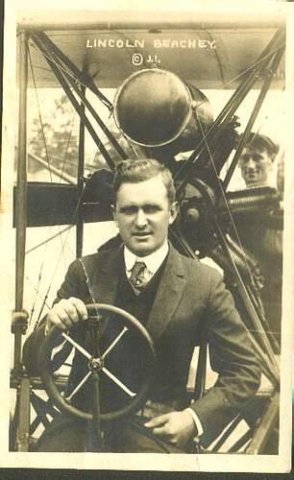1990 Lincoln Beachey
Hall of Fame’90
David Gustafson, Sport Aerobatics, from 8 February, 1991
On December 1 IAC President Steve Morris presided over the induction ceremonies for the International Aerobatic Hall of Fame. Everything went smoothly and the setting (The Riviera Hotel in Las Vegas) seemed ideal for the ceremonies.
For 1990, the program was shifted from a stand-alone event at the EAA Aviation Museum to being part of the annual convention of the International Council of Airshows (ICAS). Since Lincoln Beachey, Bob Herndeen, Carlie Hillard and Art Scholl have all been active in the airshow industry, everyone present could relate to the people who were honored and the response was enthusiastic.
This year, for the first time, the inductee’s names were kept secret up to the last minute. Bob Herendeen and his wife were there, Charlie Hillard and his wife were present and Judy Scholl was at the banquet to present the annual Art Scholl Award. The element of surprise was undoubtedly a factor in the emotional response of Bob, Charlie and Judy. In Bob’s and Charlie’s cases, the wives were let in on the secret to assure attendance. We knew Judy Scholl would be there to present the annual Art Scholl Award.
Since some of the ICAS members didn’t even know there is an Aerobatic Hall of Fame, Steve explained that the Hall is housed in the EAA Aviation Museum…anyone can nominate someone who has made a significant contribution to the field of aerobatics.
Herendeen, Hillard and Scholl received standing ovations when their names were called and the applause was long, warm and enthusiastic.
Here’s what Steve said about each of the four men who were honored and added to the International Aereobatics Hall of Fame:
Lincoln Beachey

Lincoln Beachey (1887 – 1915) became the first aerobatic pilot to achieve star status. He joined Glenn Curtiss’ aerial demonstration team in 1911 and quickly earned the title of daredevil. He was the first to fly a loop in the United States, first to barrel roll, and the first to demonstrate prolonged inverted flight. Lincoln was involved in the development of his famous “Little Looper” and was instrumental in the placement of ailerons at the trailing edge of the wing. It’s believed that Beachey was one of the first performers to incorporate spin and vertical (downward) rolls. His famous Death Dip, a dive from 5,000 feet of the ground before pulling up, brought crowds to the feet and caused some people to faint. Always on the lookout for something new, something more maneuverable, Beachey developed a radical new monoplane with tricycle gear in 1915. Though it was flawed, Beachey was persuaded to fly it over San Francisco Bay. The aircraft disintegrated in the dive, but Beachey’s reputation as an extraordinary pilot was forever established in the history books.
In 1911 an aeronaut named Lincoln Beachey was beginning to make a name for himself. When Orville and Wilbur Wright were completing their historic flight, Lincoln was already well entrenched in his aerial career working with balloons and airships. In 1905, Lincoln, and his brother Hillery, had full time work in aviation. Lincoln was becoming one of the most successful airship aeronauts in the U.S.
Due to eh limited capabilities of the aircraft of the day, aerial demonstrations were more a test of keeping an aircraft in control rather than wringing them out with Loops, Hammerheads and split S’s. By the winter of 1910, Lincoln was considered a professional aviator, and by the middle of 1911, he was well known throughout the United States. While flying for Curtiss as a test pilot and exhibition flyer, Beachey dove a Curtiss model D Headless biplane into the Niagara Falls Gorgel Pulling it out of its dive just twenty feet above the water he went under a suspension bridge and pulled out of the narrowing gorge on the other end. At the 1911 Chicago International Aviation Meet, Lincoln Beachey obtained the world’s record for altitude flight. He reached just over 12,000 feet before running out of fuel and having to glide back to earth.
Beachey is also known for being the first American aviator to loop an aeroplane. Between November 1913 and November 1914 he completed over 1,000 loops. The year 1914 marked the high point of exhibition flying in the United States, but due to the war in Europe civilian flying was put on temporary hold.
On March 14, 1915, just a few weeks after his 28th birghday, while performing before a crowd of 50,000 at the Panama-Pacific International Exposition, Beachey’s plane, a Beachey-Eaton Monoplan, broke up while performing aerobatics. His death marked the end of exhibition flying in the U.S. the likes of the Panama-Pacific International Exposition and the Chicago International Aviation Meet. Although this was the close of one era it opened the door to the era of individual aviators.

